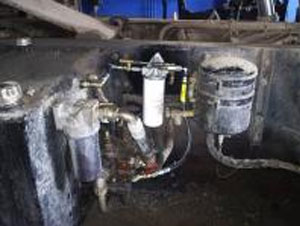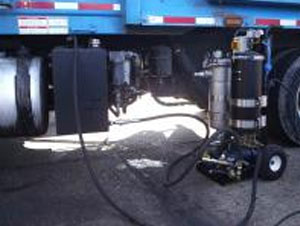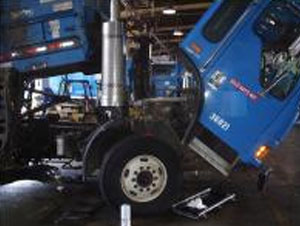Extending Oil Life on Trucks
|
THE PROBLEM Harvard Corporation recently worked with the Solid Waste Management Department of a large U.S. City. The goal of the project was to extend the hydraulic and engine oil life on their trucks. The Department was noticing that they were spending a lot of time and money changing engine oil every month, and also changing hydraulic oil on a yearly basis. They wanted a way to control and contain contamination (solids and moisture) from getting into the hydraulic and engine oils. This could be done by reducing contaminants ingression and improving filtration. Here were their targets to accomplish:
Our client knew that reducing downtime through better filtration was a huge factor in improving their bottom line. This is because contamination in lubricants is responsible for as much as 80% of the wear that leads to mechanical failure. THE SOLUTION Hydraulic Oil Our customer used one of their garbage trucks to test the effectiveness of the proposed solution. They first took a sample of hydraulic oil from the truck, which had high levels of solid and moisture contaminants exceeding ISO cleanliness (ISO 27/24/18). Here was their solution:
After 90 days, another sample of hydraulic oil was taken from the truck. The new ISO cleanliness was ISO 16/13/10. Engine Oil Our customer used the same garbage truck to test the proposed solution for their engine oil. The first sample of engine oil from the truck contained a high level of soot, indicating possible injector failures. The ISO cleanliess rating was 21/20/17 with a Soot Rating of .712. Here was their solution:
After 40 days, another sample of engine oil was taken from the truck. The new ISO cleanliness was ISO 17/16/13 with a Soot Rating of .324. IMPACT Needless to say, our customer was very happy after seeing results from Harvard's solutions. With the use of Harvard off-line filtration system, Harvard portable filtration cart and Desiccant breather, they were able to recover the hydraulic oil and keep it cleaner than new oil. No future hydraulic changes are necessary. As for engine oil, with the use of a Harvard off-line filtration system the oil remained free of contaminants, extending the oil drain interval from 1 month to 3 months. This equates to changing engine oil only 4 times a year instead of 12 times a year! CONCLUSION Our customer was able to enjoy a 100% ROI in less than a year! They did this by:
Contaminants like debris and moisture are the primary cause of wear and failure. Controlling contaminants WILL save you money. Contact Harvard Corporation today to learn how to control contamination and identify the savings. |
|||||||||||||||
|
|
THE PROBLEM Harvard Corporation recently worked with the Solid Waste Management Department of a large U.S. City. The goal of the project was to extend the hydraulic and engine oil life on their trucks. The Department was noticing that they were spending a lot of time and money changing engine oil every month, and also changing hydraulic oil on a yearly basis. They wanted a way to control and contain contamination (solids and moisture) from getting into the hydraulic and engine oils. This could be done by reducing contaminants ingression and improving filtration. Here were their targets to accomplish:
Our client knew that reducing downtime through better filtration was a huge factor in improving their bottom line. This is because contamination in lubricants is responsible for as much as 80% of the wear that leads to mechanical failure. THE SOLUTION Hydraulic Oil Our customer used one of their garbage trucks to test the effectiveness of the proposed solution. They first took a sample of hydraulic oil from the truck, which had high levels of solid and moisture contaminants exceeding ISO cleanliness (ISO 27/24/18). Here was their solution:
After 90 days, another sample of hydraulic oil was taken from the truck. The new ISO cleanliness was ISO 16/13/10. Engine Oil Our customer used the same garbage truck to test the proposed solution for their engine oil. The first sample of engine oil from the truck contained a high level of soot, indicating possible injector failures. The ISO cleanliess rating was 21/20/17 with a Soot Rating of .712. Here was their solution:
After 40 days, another sample of engine oil was taken from the truck. The new ISO cleanliness was ISO 17/16/13 with a Soot Rating of .324. IMPACT Needless to say, our customer was very happy after seeing results from Harvard's solutions. With the use of Harvard off-line filtration system, Harvard portable filtration cart and Desiccant breather, they were able to recover the hydraulic oil and keep it cleaner than new oil. No future hydraulic changes are necessary. As for engine oil, with the use of a Harvard off-line filtration system the oil remained free of contaminants, extending the oil drain interval from 1 month to 3 months. This equates to changing engine oil only 4 times a year instead of 12 times a year! CONCLUSION Our customer was able to enjoy a 100% ROI in less than a year! They did this by:
Contaminants like debris and moisture are the primary cause of wear and failure. Controlling contaminants WILL save you money. Contact Harvard Corporation today to learn how to control contamination and identify the savings. |
|||||||||||||||
|













